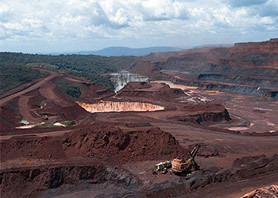The Brazilian territory is rich in ores, being one of the greatest explorers in the world, along with Russia, the United States, Canada, China and Australia. This was possible due to investments that led to the growth of this activity in recent decades.
Most mining companies are not genuinely Brazilian, as many are associated with other foreign companies, mainly from the United States, Canada, Japan and Europe. Foreign companies introduced technologies in the extraction of minerals and promoted a significant increase in production.
To consolidate the mining projects, huge investments were needed by the mining companies and also by the Brazilian government, which created infrastructure to support such an undertaking, such as the construction of hydroelectric plants, railways and ports. All this to facilitate the extraction and flow of production.
Foreign mining companies established themselves in Brazil attracted by incentives offered by the government, such as abundant mineral resources, tax incentives, bank financing, discounts on energy payments and taxes.

Serra dos Carajás
The efforts employed by the Brazilian government have not brought satisfactory returns to the country, because a large part of the production is destined for the foreign market, sold at low prices. Also including that the profits obtained by foreign companies do not remain in Brazil, on the contrary, they are sent to the countries of origin.
Currently, the main ores extracted in Brazil are: iron, bauxite (aluminum), manganese and niobium. Brazil is the second largest producer of iron of the world, with about 235 million tons. It is extracted from deposits located in the Quadrilátero Ferrífero, in Minas Gerais; in Serra dos Carajás, in Pará; and in Maciço do Urucum, in Mato Grosso do Sul. Iron is the main component in steel making.
In the production of bauxite, Brazil is the third in the world, with a production of approximately 17.4 million tons. Its extraction takes place exclusively in the Serra do Oriximiná, in the state of Pará. This ore is used in the manufacture of aluminum, an important raw material in the production of household appliances, electrical material, among many others.
Do not stop now... There's more after the advertising ;)
The country is the third world producer of manganese, with an approximate production of 1.3 million tons per year. Its extraction takes place, especially, in deposits located in Serra dos Carajás, Quadrilátero Ferrífero and Maciço do Urucum. A large part of the production is destined for the foreign market, being absorbed mainly by the United States, Europe and Japan. The use of manganese is linked to the manufacture of steel and various chemical products.
The Brazilian territory is also rich in niobium, with an annual production of 38 thousand tons, a volume that places the country in first place in the world in the extraction of this ore. The niobium reserves are basically found in Minas Gerais and Goiás. This ore is very important, being used in the manufacture of aircraft turbines, magnetic resonance devices and supercomputers.
By Eduardo de Freitas
Graduated in Geography
Brazil School Team
Would you like to reference this text in a school or academic work? Look:
FREITAS, Eduardo de. "Main ore producing areas in Brazil"; Brazil School. Available in: https://brasilescola.uol.com.br/brasil/principais-areas-produtoras-minerio.htm. Accessed on June 28, 2021.
